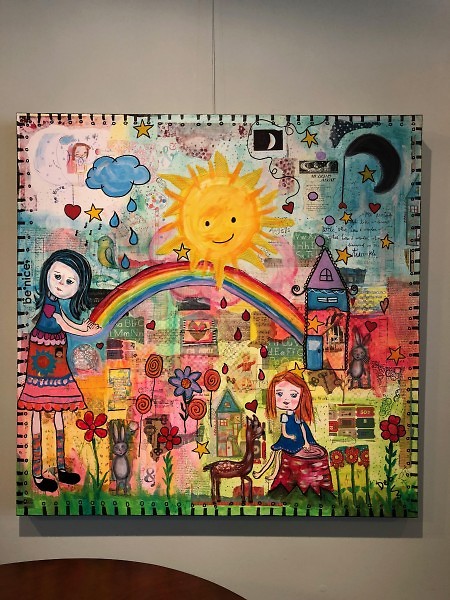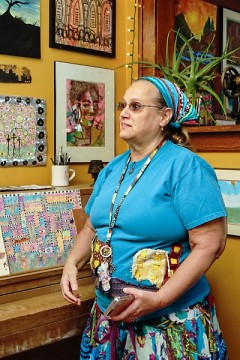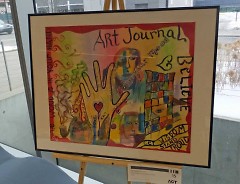An exhibition of Debra Dieppa’s recent work is now on display in the West Lobby at the Wealthy Street Theatre. The conversation below between the artist and her longtime friend, and curator, Elizabeth Jane VanArragon of her upcoming exhibition at the Biggen Gallery at Auburn University, in Alabama, surveys her unique, assemblage style of painting and the growth of her creative practice. Dieppa has been very open in the past about her experiences as an abuse survivor and a person with a disability. In this conversation she focuses on her process and philosophy as an artist.
Liz VanArragon or LV: The colors in your current paintings are so bright and cheerful. What guides in your choice of colors?
DD: Before I used [these] colors, my world seemed very dark. Now my heart longs to see the beauty in all the different colors around me. I enjoy taking a dark color and blending it with lighter colors and adding white to see what new colors I can create.
LV: Sometimes, even though you’re using bright colors, your pictures seem to be portraying sad or frightening memories or associations. Can you talk about what it means to you to portray your past through your current brighter color palette?
DD: As a child I can remember the colors of things but my mind was in a dark place. So now that I have been healing, my mind sees all the colors brighter and my imagination takes over on how I wish I could have enjoyed the beauty back then. In my newer art there are layers and layers of my past. Children’s book pages, items, tickets, and bingo cards. You can find images of keys, hearts, clocks, etc. Then images of the sun, stars and moon. Houses invite you to ask what or how things are going inside the home, and how these things remind you of your past.
LV: Fascinating, it sounds as if the objects you see or find in the present, whether something from nature that you represent, or a toy or book page that you collage into the painting, bring you back into the past.
DD: Yes. My mind is working on re-associating the positive things and working on discarding the negative things.
LV: Do you remember when you started to integrate found things into your paintings?
DD: It started about 10 years ago. At first it was a piece of old jewelry, and then I started adding silverware from when I was a small child. I can remember how me and my siblings would always argue over these little silverware at my great-grandmother’s home and how it became upsetting to me. It really was healing for me.
LV: There are certain symbols, characters, like visual themes that reappear in your paintings. Can you talk about some of the elements that you often use in your pictures?
DD: Houses. It is always a question for me, like what goes on in each home. The houses all look somewhat alike, maybe a different color here and there. But what happens inside? Because each family has different dynamics. My question is how do their dinners go? What are their bedtimes like? Are they happy or sad? Do they all treat each other with respect? Are they kind to one another? Do they have secrets?
Tickets and keys. When [we were] younger and we would go to a movie or penny carnival I loved holding my tickets. The colors, and what I could do with them was so exciting to me. I guess maybe it was because I could actually have a say in something that I was doing.
The keys, I loved the different sizes and shapes. Somehow it allowed me to feel safe. If I could figure out how to use the, and maybe one would open a door to a world of happiness and colors.
LV: Deb you often use words in your paintings in addition to the images, sometimes words collaged from books or other sources, sometimes you write words into the paintings. Can you describe how the words come to you—do your paintings start with words, or do you start with the images?
DD: I first start with colors that I long to see, then from the colors depending on where my mind and heart goes there come different objects. After the objects I find my mind going to different images in my mind from the past to the present and what if’s. I let myself go and follow my hand and brush, then the magic appears.
LV: Do you include words to explain what you’re thinking and feeling? Or are the words part of the process of your thinking as the painting develops? For example, one of your paintings from several years ago has the words, “Art is no threat to public safety”. I love that painting—it’s sort of charming and whimsical and yet the words are a message aren’t they?
DD: Yes, I like that painting too. People were talking about art at a gallery that I was painting in and talking about how art was a threat to some people and the community. So I just had to add those words because art is more of the creative spirit and cannot harm someone.
One of my other paintings that I did, She was made of magic that only I could see, was about what things were magical hidden in the piece. I think about each piece and how it will leave someone thinking about the context of the painting. And then I think about what it speaks to me and the words just fit. That’s how they come to me, [they’re] for myself.
LV: When did you start painting, Deb?
DD: Back in 1998 or 1999. My first therapist referred me to Heartside Gallery. He told me I needed a way to get what was inside out. A more visual experience instead of it all being trapped in my mind.
LV: What did you paint when you started?
DD: It was difficult for me to find color. At first everything was brown, black, kind of muddy. Then red became a choice of color, it helped me with the pain inside.
At first I didn’t want anything to touch, and was afraid of making a mess. Then I started touching the paint and smearing it. There was this lady with a beautiful soul that stepped in and introduced me to colors one by one. She always listened to me and helped me through my emotional experience. Her name was Kerri.
Heartside became a very healing place for me. I couldn’t get enough of it. I was attending Heartside every day and pouring my mind out onto paper, boards, whatever I could get my hands on.
LV: You now have a developed visual language that is uniquely your own. Do you remember when you found your own style as an artist, when you knew how to set up a composition in your own way?
DD: Not sure when and how it came about, but as I start a painting and my mind takes over and goes in whatever direction it takes me. When an object comes inside of me I place it and build around it. Soon an image comes to me and then he or she is created.
LV: One of the words that come to my mind when I look at your work is “transformation.” You take something and change it, translate ideas into new forms, make materials and objects into something else and help us see familiar things in new ways. What does transformation mean to you?
DD: Transformation means a lot to me. I work at meeting my past and my present and finding the joy and beauty in today.
LV: What do you hope your viewers find when they see your work?
DD: I believe that people relate to my word because of all the images in my painting. A lot of things are kinda nostalgic from my era. Also everyone can take it back to their minds and memories and apply it to how it relates to their past. I believe that there can be an appreciation for each person.
LV: Last question, Deb. Your business card has an image that reads “Art belongs to everyone.” What does that phrase mean to you as a personal motto or mantra?
DD: This one is a little difficult for me because it goes deep to my heart. I never really knew how much art is inside of me, and how it is really in everyone. I believe that Art is the beginning of everything. Colors, shapes, motion, music, dance, expression of mind, body, spirit.
The first time I heard this quote, it took me awhile to process it. The words really go my mind to think. Then one day I saw it written on the ground and I had to take a picture of it. I walked around the park. I kept coming back to read it again and again. I sat for quite some time to reflect on how it was such a small quote but such a huge statement.
I know that we put prices on art but really anything that is visual art, or [art that we are] able to watch or listen to, it’s there for the taking. We just need to absorb it. Take advantage of it. No one can really steal our minds. That is one thing we have control over. It might get lost or damaged here or there but when we come back to it we can still have that in our minds.
The Rapidian, a program of the 501(c)3 nonprofit Community Media Center, relies on the community’s support to help cover the cost of training reporters and publishing content.
We need your help.
If each of our readers and content creators who values this community platform help support its creation and maintenance, The Rapidian can continue to educate and facilitate a conversation around issues for years to come.
Please support The Rapidian and make a contribution today.


